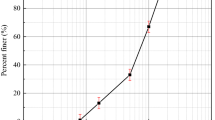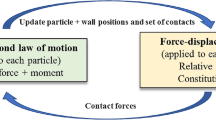Abstract
This study presents a numerical investigation of the shear strength and deformation behaviors of sand-clay interfaces through the distinct element method (DEM). Numerical direct shearing modeling was carried out in PFC2D (particle flow code), considering the effects of the interface geometry, stiffness ratio, friction coefficient, and soil properties. Results indicate that the interface shear strength is greatly mannered by the sample strength and loading conditions. Shear stress curves of samples with smooth interfaces, general stiffness ratio and friction coefficient feature softening behavior that experience peak strengths. The deformation is intensely localized in a narrow shear zone which is below the mid-height of samples. The sample with a sawtooth interface has lower shear strength but more coordination number. With the increase of stiffness ratio, the internal friction angle becomes smaller, and the force chain distribution becomes more uniform. Furthermore, there is an infinitesimally impact from the friction coefficient on the interface shear strength. However, the mesoscopic sliding fraction is greatly affected by the particle friction coefficient. When the bond strength is extremely large, the force chain exhibits uniform dense distribution with central symmetry along the diagonal, corresponding to more coordination number.

















Similar content being viewed by others
References
Cerato AB, Lutenegger AJ (2006) Specimen size and scale effects of direct shear box tests of sands. Geotech Test J 29(6):507–516
Chai JC, Saito A (2016) Interface shear strengths between geosynthetics and clayey Soils. Int J Geosynth Ground Eng 2(3):19
Chen XB, Zhang JS, Xiao YJ et al (2015) Effect of roughness on shear behavior of red clay-concrete interface in large-scale direct shear tests. Can Geotech J 52(8):1122–1135
Chen WB, Zhou WH, Jing XY (2017) Effects of shear direction on the shearing behavior of a soil-structural interface using discrete element method. In: Lee W, Lee JS, Kim HK (eds) Proceedings of the 19th international conference on soil mechanics and geotechnical engineering. Korea Geotechnical Society, Seoul, pp 703–706
Chiu CC, Weng MC (2019a) DEM simulation of planar sliding using a particulate interface model considering velocity-dependent friction. Comput Geotech 112:51–59
Chiu CC, Weng MC (2019b) Simulating interface characteristics by using a particulate interface model of a discrete element method. Comput Geotech 109:1–11
Feng WQ, Li C, Yin JH et al (2019) Physical model study on the clay-sand interface without and with geotextile separator. Acta Geotech 14(6):2065–2081
Frikha W, Jellali B (2018) Numerical and experimental studies of sand-clay interface. In: Bouassida M, Meguid MA (eds) Proceedings of the 1st GeoMEast international congress and exhibition: ground improvement and earth structures. Springer, Cham, pp 108–120
Gomez JE, Filz GM, Ebeling RM et al (2008) Sand-to-concrete interface response to complex load paths in a large displacement shear box. Geotech Test J 31(4):358–369
Gu XQ, Huang MS, Qian JG (2014) Discrete element modeling of shear band in granular materials. Theoret Appl Fract Mech 72:37–49
Guo N, Zhao JD (2013) The signature of shear-induced anisotropy in granular media. Comput Geotech 47:1–15
Hu LM, Pu JL (2004) Testing and modeling of soil-structure interface. J Geotechn Geoenviron Eng 130(8):851–860
Hu LM, Zhang BY, Ma J (2010) Mechanical characteristics for interfaces between granular materials. Mech Res Commun 37(1):42–46
Jewell RA (1989) Direct shear tests on sand. Geotechnique 39(2):309–322
Jiang MJ, Yan HB, Zhu HH et al (2011) Modeling shear behavior and strain localization in cemented sands by two-dimensional distinct element method analyses. Comput Geotech 38:14–29
Jing XY, Zhou WH, Li YM (2017) Interface direct shearing behavior between soil and saw-tooth surfaces by DEM simulation. Proced Eng 175:36–42
Kasmer O, Ulusay R (2006) Stability of spoil piles at two coal mines in turkey: geotechnical characterization and design considerations. Environ Eng Geosci 12(4):337–352
Kock I, Huhn K (2007a) Influence of particle shape on the frictional strength of sediments: a numerical case study. Sed Geol 196(1):217–233
Kock I, Huhn K (2007b) Numerical investigation of localization and micromechanics in a stratified soil specimen. J Struct Geol 29(10):1679–1694
Kristensen MB, Childs C, Olesen NO et al (2013) The microstructure and internal architecture of shear bands in sand-clay sequences. J Struct Geol 46:129–141
Lashkari A (2017) A simple critical state interface model and its application in prediction of shaft resistance of non-displacement piles in sand. Comput Geotech 88:95–110
Lei D, Huang JF, Xu WX et al (2018) Deformation analysis of shear band in granular materials via a robust plane shear test and numerical simulation. Powder Technol 323:385–392
Li YK, Han XL, Ji J et al (2015) Behavior of interfaces between granular soil and structure: a state-of-the-art review. Open Civil Eng J 9:213–223
Liu CN, Ho YH, Huang JW (2009) Large scale direct shear tests of soil/PET-yarn geogrid interfaces. Geotext Geomembr 27(1):19–30
Martinez A, Stutz H (2019) Rate effects on the interface shear behaviour of normally and over-consolidated clay. Geotechnique 69(9):801–815
Morgan JK (1999) Numerical simulations of granular shear zones using the distinct element method, 2: effects of particle size distribution and interparticle friction on mechanical behavior. J Geophys Res 104(B2):2721–2732
Morgan JK, Boettcher MS (1999) Numerical simulations of granular shear zones using the distinct element method, 1: shear zone kinematics and the micromechanics of localization. J Geophys Res 104(B2):2703–2719
Seyferth M, Henk A (2006) A numerical sandbox: high-resolution distinct element models of halfgraben formation. Int J Earth Sci 95(2):189–203
Shi S, Zhang F, Feng DC et al (2020) Experimental investigation on shear characteristics of ice-frozen clay interface. Cold Reg Sci Technol 176:1090
Shibuya S, Mitachi T, Tamate S (1997) Interpretation of direct shear box testing of sands as quasi-simple shear. Geotechnique 47(4):769–790
Tamassoki S, Moayed RZ, Ashkani M et al (2018) Scale effect on the shear strength of two-layer soil reinforced by geogrid. Malays J Civil Eng 30(1):113–127
Teh KL, Cassidy MJ, Leung CF et al (2008) Revealing the bearing capacity mechanisms of a penetrating spudcan through sand overlying clay. Geotechnique 58(10):793–804
Tong L, Wang YH (2015) DEM simulations of shear modulus and damping ratio of sand with emphasis on the effects of particle number, particle shape, and aging. Acta Geotech 10(1):117–130
Wu PK, Matsushima K, Tatsuoka F (2008) Effects of specimen size and some other factors on the strength and deformation of granular soil in direct shear tests. Geotech Test J 31(1):45–64
Zhang L, Thornton C (2007) A numerical examination of the direct shear test. Geotechnique 57(4):343–354
Zhang G, Zhang JM (2006) Monotonic and cyclic tests of interface between structure and gravelly soil. Soils Found 46(4):505–518
Zhang ZL, Cui ZD, Zhao LZ (2020) Shear strength of sand-clay interfaces through large-scale direct shear tests. Arab J Sci Eng 45(5):4343–4357
Zhao LZ (2016) Mechanical characteristics and deformation of the interface between double layers of soil. China University of Mining and Technology, Xuzhou
Zhou LM, Zhu ZD, Yu ZP et al (2020) Shear testing of the interfacial friction between an HDPE geomembrane and solid waste. Materials 13(7):1672
Zhu HX, Zhou WH, Jing XY et al (2017) Numerical study of the formation of shear bands in soil under interface shearing. Proced Eng 175:102–109
Acknowledgements
The work in this paper was supported by Outstanding Innovation Scholarship for Doctoral Candidate of CUMT (Grant No. 2018BSCXC41).
Funding
This research was supported by Outstanding Innovation Scholarship for Doctoral Candidate of CUMT (Grant No. 2018BSCXC41).
Author information
Authors and Affiliations
Corresponding author
Ethics declarations
Conflict of interest
The authors declare that they have no known competing financial interests or personal relationships that could have appeared to influence the work reported in this paper.
Additional information
Publisher's Note
Springer Nature remains neutral with regard to jurisdictional claims in published maps and institutional affiliations.
Rights and permissions
About this article
Cite this article
Zhang, ZL., Cui, ZD. & Zhao, LZ. Modeling shear behavior of sand-clay interfaces through two-dimensional distinct element method analysis. Environ Earth Sci 81, 140 (2022). https://doi.org/10.1007/s12665-022-10244-9
Received:
Accepted:
Published:
DOI: https://doi.org/10.1007/s12665-022-10244-9




